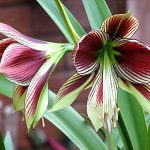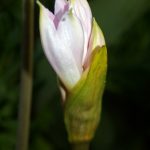We love Hippeastrum (Amaryllis)
Posted:2 March 2018
Early March is not too late to enjoy the gorgeous, elegant, large flowered Hippeastrum (Amaryllis), and it is still possible to find a great range, both in shape of flower and colour from white, pale pink to deep purple-reds, and oranges.
Quick Tips:
- Planting Period: October until the end of April.
- Flowering Period: Late December until the end of June.
- Flowering time is 6 -10 weeks.
- Larger bulbs produce more flowers.
- Always store un-planted bulbs in a cool place
- Submerge roots and the base of the bulb in tepid water for several hours prior to planting
Amaryllis bulbs are huge, some up to 12 cm across, and they like a tight fit in their pot, so leave only about 2.5 cm between the bulb and the side, if planting only one. They thrive on being crowded. The pot should be twice the depth of the size of bulb. I plant 3 or 5 (depending on size of bulb) in a Victorian wash bowl for maximum impact!
leave only about 2.5 cm between the bulb and the side, if planting only one. They thrive on being crowded. The pot should be twice the depth of the size of bulb. I plant 3 or 5 (depending on size of bulb) in a Victorian wash bowl for maximum impact!
Amaryllis bulbs have a tendency to rot and drainage is vital so put a handful of crocks in the bottom of the pot. Using a mix of multi-purpose compost and horticultural grit or perlite, plant the bulbs so that one-third of the bulb remains above the surface. Taking care not to damage the roots, press the soil down firmly to set the bulb securely in place. Water in well, although avoid watering the bulb itself as it is vulnerable. Use tepid tap water. If like me you are using a bowl without holes in the bottom of it, you must water with great care so as to avoid water logging.
 Regular checks need to be made on the moistness of the compost so it doesn’t dry out. Once leaves start to appear you know that root activity has begun and the plants need regular watering. You can also give a weak liquid feed every month to build up the bulb so you can enjoy its beauty next year.
Regular checks need to be made on the moistness of the compost so it doesn’t dry out. Once leaves start to appear you know that root activity has begun and the plants need regular watering. You can also give a weak liquid feed every month to build up the bulb so you can enjoy its beauty next year.
As Amaryllis originate from South Africa a warm and sunny position, free from draughts, with a temperature of 15-20c, is ideal for good growth. The plant should flower within six to eight weeks. As soon as the flowers start to open, move the plant to a cooler place, 10-15c, to prolong their life. Supporting the developing plants with a ring of twigs (birch or hazel) will both look beautiful, and prevent the tall stems from flopping. With the largest of the bulbs you should enjoy at least 3 consecutive flower stems.
When they are finished cut the old flower stems down to the base, leaving the foliage to continue photosynthesising in a warm and light situation. Continue watering and feeding until the leaves start to shrivel. Stop watering and keep the bulb somewhere dry, cool and dark until the late autumn.

